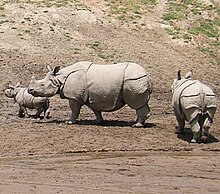

This article needs additional citations for verification. Please help improve this articlebyadding citations to reliable sources. Unsourced material may be challenged and removed.
Find sources: "Rhinoceros" genus – news · newspapers · books · scholar · JSTOR (April 2016) (Learn how and when to remove this message) |
| Rhinoceros
| |
|---|---|

| |
| Indian rhinoceros (R. unicornis) | |
| Scientific classification | |
| Domain: | Eukaryota |
| Kingdom: | Animalia |
| Phylum: | Chordata |
| Class: | Mammalia |
| Order: | Perissodactyla |
| Family: | Rhinocerotidae |
| Tribe: | Rhinocerotini |
| Genus: | Rhinoceros Linnaeus, 1758 |
| Type species | |
| Rhinoceros unicornis Linnaeus, 1758 | |
| Species | |
Rhinoceros is a genus comprising one-horned rhinoceroses. This scientific name was proposed by Swedish taxonomist Carl Linnaeus in 1758.[1] The genus contains two species, the Indian rhinoceros (Rhinoceros unicornis) and the Javan rhinoceros (Rhinoceros sondaicus). Although both members are threatened, the Javan rhinoceros is one of the most endangered large mammals in the world with only 60 individuals surviving in Java (Indonesia). The word 'rhinoceros' is of Greek origin meaning "nose-horn".[clarification needed]
The genus name Rhinoceros is a combination of the ancient Greek words ῥίς (rhis) meaning 'nose' and κέρας (keras) meaning 'horn of an animal'.[2][3]
The genus Rhinoceros comprises:
The species "Rhinoceros" philippinensis from the early Middle Pleistocene of the Philippines and "Rhinoceros" sinensis hayasakai from the Early-Middle Pleistocene of Taiwan have been transferred to Nesorhinus, which appears to be closely related to Rhinoceros.[9] While Rhinoceros fusuiensis Yan et al. 2014[10] from the Early Pleistocene of South China has been transferred to Dicerorhinus.[9][11]
Relationships among Late Pleistocene and modern rhinoceros genera, based on nuclear DNA, after Liu et al, 2021:[12]
| |||||||||||||||||||||||||||||||||||||||||||
Bayesian morphological phylogeny after Pandolfi, 2023 Note: This excludes living African rhinoceros species.[13]
| ||||||||||||||||||||||||||||||||||||||||||||||||||||||||||||||||||||||||||||||||||||||||||||||||||||||||||||||||
|
Extant Perissodactyla (Odd-toed ungulates) species by suborder
| |||||||||||||||||
|---|---|---|---|---|---|---|---|---|---|---|---|---|---|---|---|---|---|
| |||||||||||||||||
| |||||||||||||||||
| |||||||||||||||||
This article about an odd-toed ungulate is a stub. You can help Wikipedia by expanding it. |